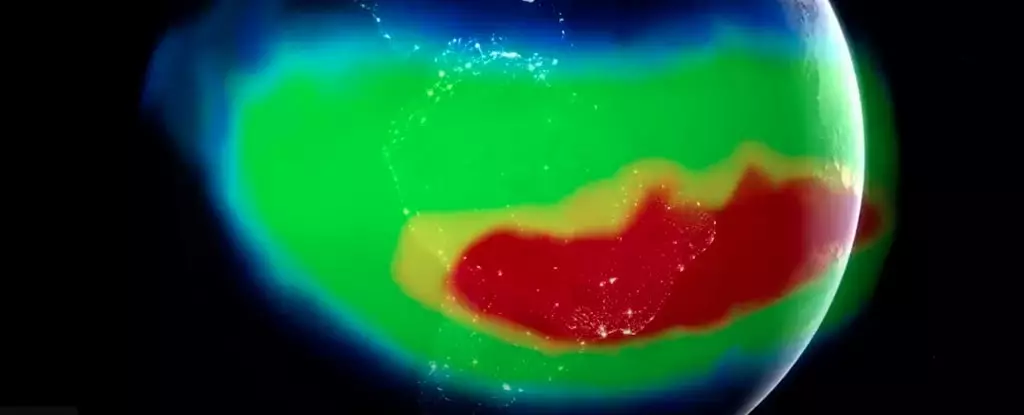In the vast, ionized expanse of space that envelops our planet lies a phenomenon both mysterious and troubling: the South Atlantic Anomaly (SAA). This extensive region, characterized by a notable dip in Earth’s magnetic field strength, stretches elegantly between the coasts of South America and southwest Africa. For decades, scientists have scrutinized this anomaly, in particular, NASA’s researchers, who are tasked with untangling its complex nature and understanding its implications for our technology and our planet. The SAA, often described as a “dent” in the magnetic shield of Earth, raises both curiosity and concern—not for life on the ground, but predominantly for the delicate instruments orbiting overhead.
The Risks to Orbiting Technology
The threat the South Atlantic Anomaly poses to various satellites and the International Space Station (ISS) is significant. As these craft traverse the low-Earth orbit of the Anomaly, they enter an area where the magnetic field’s strength drops alarmingly low. This situation leads to an uptick in exposure to high-energy protons from the Sun. While this may sound benign, it poses serious risks; electronic systems aboard these vessels can malfunction due to glitches caused by these charged particles. In the worst-case scenario, the resulting cognitive dissonance between the data collected and the reality of ongoing operations may lead to catastrophic data loss or even the permanent failure of critical systems. As a result, satellite operators must initiate shutdown protocols whenever traversing the SAA, a necessary but disruptive measure that speaks volumes about the nature of this peculiar anomaly.
A Gateway to Understanding Earth’s Magnetism
Despite the hazards it presents, the South Atlantic Anomaly represents a unique opportunity to explore the intricacies of Earth’s magnetic field. Terry Sabaka, a geophysicist from NASA’s Goddard Space Flight Center, characterizes Earth’s magnetic field as a mosaic of currents generated deep within our planet’s mantle and outer core. These flows create a magnetic environment that is neither static nor predictable. Intriguingly, the SAA may arise due to the interplay of various geological features, including a large low-shear velocity province located nearly 2,900 kilometers below the African continent, which complicates and disrupts the magnetic field generation process. Understanding these dynamics may hold the key to numerous questions surrounding not just the SAA, but the broader behavior of Earth’s magnetism itself.
The Malfunctioning Dipole and Its Consequences
Further complicating matters, researchers describe the existing magnetic conditions of the SAA as reflective of a decreased predominance of the conventional dipole magnetic field. Specific localized fields with reversed polarity have emerged, contributing to the marked weakness in magnetic intensity felt in this region. Weijia Kuang, a mathematician and geophysicist from NASA, notes the growing strength of this opposing magnetic field, further adding layers to the intricate tapestry of our planet’s geophysical mysteries. What does this mean for Earth’s future magnetic environment? Might the SAA’s unusual characteristics hint at impending shifts in magnetic patterns or even foreshadow global magnetic flips? These concerns necessitate ongoing investigation, as scientists strive to decode this enigmatic behavior.
The Gradual Transformation of the Anomaly
More fascinating revelations arise as researchers track the movement of the SAA. Unlike a static hazard, evidence suggests that the anomaly slowly drifts and evolves. Notably, satellite data gathered from CubeSats has confirmed that the anomaly is undergoing a division, potentially breaking into two distinct regions of reduced magnetic intensity. As our understanding of the mechanics behind the SAA grows, it becomes clear that we are facing more than just a local issue; we are witnessing a unique and possibly historical geophysical event that weighs heavily on the imagination of scientists.
A Legacy of Magnetic Evolution
Digging deeper into the historical context of the SAA reveals an even more perplexing narrative. Research hints that the anomaly is not merely a recent occurrence but rather a recurring event that may have manifested throughout various epochs of Earth’s geological timeline. Some estimates suggest it may have influenced our planet’s magnetism for as far back as 11 million years, challenging the notion that such occurrences are modern anomalies. This brings to light essential questions about magnetic field reversals and their frequency, suggesting that the SAA may not serve as a precursor to drastic geomagnetic shifts but rather as a complex natural occurrence within Earth’s magnetic stability.
As we dissect the dimensions of the South Atlantic Anomaly, the layered complexities and implications locked within its magnetic fog encourage further inquiry and innovation in scientific methodology. The enchantment of our planet’s magnetism captivates and perplexes, shaping the identity and future of the Earth itself, and reiterating the imperative of continued observation and research in this crucial field.


Leave a Reply